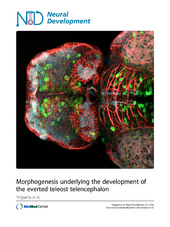| dc.description.abstract | Background: Although the mechanisms underlying brain patterning and regionalization are very much conserved, the morphology of different brain regions is extraordinarily variable across vertebrate phylogeny. This is especially manifest in the telencephalon, where the most dramatic variation is seen between ray-finned fish, which have an everted telencephalon, and all other vertebrates, which have an evaginated telencephalon. The mechanisms that generate these distinct morphologies are not well understood. Results: Here we study the morphogenesis of the zebrafish telencephalon from 12 hours post fertilization (hpf) to 5 days post fertilization (dpf) by analyzing forebrain ventricle formation, evolving patterns of gene and transgene expression, neuronal organization, and fate mapping. Our results highlight two key events in telencephalon morphogenesis. First, the formation of a deep ventricular recess between telencephalon and diencephalon, the anterior intraencephalic sulcus (AIS), effectively creates a posterior ventricular wall to the telencephalic lobes. This process displaces the most posterior neuroepithelial territory of the telencephalon laterally. Second, as telencephalic growth and neurogenesis proceed between days 2 and 5 of development, the pallial region of the posterior ventricular wall of the telencephalon bulges into the dorsal aspect of the AIS. This brings the ventricular zone (VZ) into close apposition with the roof of the AIS to generate a narrow ventricular space and the thin tela choroidea (tc). As the pallial VZ expands, the tc also expands over the upper surface of the telencephalon. During this period, the major axis of growth and extension of the pallial VZ is along the anteroposterior axis. This second step effectively generates an everted telencephalon by 5 dpf. Conclusion: Our description of telencephalic morphogenesis challenges the conventional model that eversion is simply due to a laterally directed outfolding of the telencephalic neuroepithelium. This may have significant bearing on understanding the eventual organization of the adult fish telencephalon. | en_US |


